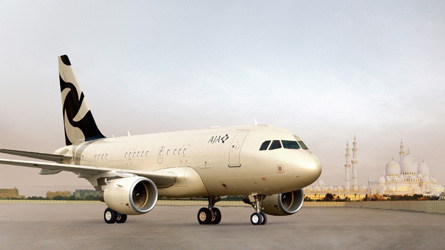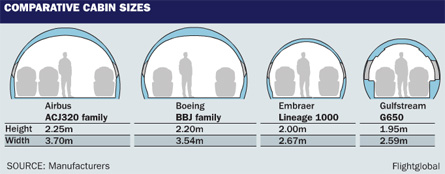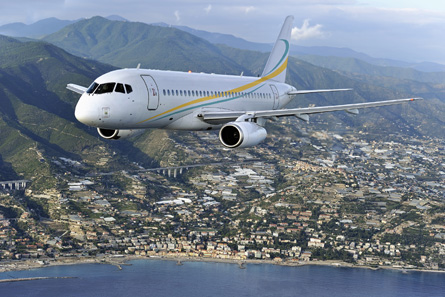Captain Steve Taylor, president of Boeing Business Jets, says ownership of corporate aircraft tends to follow a similar path to that of cars. That is to say, a driver typically starts with something small and inexpensive and gradually moves up the size and power range. Airliner-derived VIP aircraft occupy the equivalent position to a Ferrari in the business jet world. Airbus and Boeing both have a keen interest in the sector and offer their entire ranges of commercial airliners in VIP variants.
Regional jets have also enjoyed some success at the lower end of the segment. Embraer's Lineage 1000 - derived from its E-190 - has sold well since its 2007 launch. More recently, in 2011 Superjet International unveiled the Superjet Business Jet, a variant of the Superjet 100 regional aircraft, with Swiss operator Comlux the launch customer.
 |
|---|
© Boeing Boeing continues to sell healthy numbers of its BBJs with production sold out until June 2014 |
Although the overall market for business jets has taken a hammering since 2008, sales of larger aircraft, while not unaffected by the global downturn, have been more robust. And the bigger the aircraft, the stronger the orderbook. Data from trade body the General Aviation Manufacturers Association shows business jet shipments peaking at 1,313 in 2008, before falling off a cliff - between 2008 and 2011 shipments plunged 47.9% to 681. However, billings for the same period fell much less sharply, dropping 19.5% from $21.8 billion to $17.5 billion in 2011, helped by continued demand for larger jets. Boeing, for instance, delivered 28 of its 737-derived Boeing Business Jets (BBJs) during 2008 to 2011 (list prices start at $57 million). Airbus handed over an even more impressive 42 of its ACJ320-family in the same timeframe.
However, while Boeing has continued to sell healthy numbers of BBJs - production is sold out until June 2014 - sales of other aircraft in its range have stalled. Delays to the 787 and 747 programmes have been well documented. The first 787 was only handed over to Japanese carrier All Nippon Airways late last year - some four years overdue. But VIP customers have been left waiting too. Boeing Business Jets has "around 12" VIP 787s in its backlog, says Taylor, and the past few years have been very much about managing customer expectations, he adds.
"It's the worst part of the job to have to call someone and say 'we have not done what we promised'. It's a very challenging thing to do - it's not part of my DNA," he says.
UNCORKED BOTTLE
Some decided the wait was too long and cancelled their orders, but the majority of VIP 787 customers "stayed with the programme". The delays on the 787 were bad but "delivery stream has been pretty stable for a year and a half", Taylor adds. "We haven't had to have any more of 'those' conversations."
But with the bottle now uncorked, deliveries can begin apace. The first VIP 787 will be handed over to a completion centre in mid-2013, says Taylor, with "quite a bunch" following in 2014. Production on the VIP variant is sold out until 2020, although there is an opportunity to acquire three former flight-test aircraft that Boeing is selling into the VIP market.
"We are getting quite a bit of traction on those as they offer nearer-term deliveries," says Taylor. "The 787 is a very exciting product in the market and if I had a dozen of them here to sell tomorrow I could shift them very quickly."
Perhaps inevitably, the VIP 787 is being described as a "game changer" by Boeing. In its VIP guise the Rolls-Royce Trent 1000- or General Electric GEnx-1B-powered 787-8 can offer range of more than 9,000nm (16,650km) and boasts a much lower cabin altitude than previous-generation aircraft, aiding the wellbeing of its passengers. "It's a phenomenal airplane - it's the one that really grabs people's attention," says Taylor. Completion centres will also be able to take advantage of the aircraft's high ceilings and big windows, says Taylor. "We are really excited by what the completion centres can do - there are huge possibilities."
Deliveries of the VVIP 747-8 are also finally under way. The first - thought to be for Qatar's Amiri Flight - was handed over in February, with a further two aircraft due to be delivered to completion centres in the first quarter. Taylor piloted the initial 747-8 delivery flight from Seattle to a completion centre in Wichita, Kansas. He adds: "It was a great experience. Usually Boeing Business Jets, in the grand Boeing scheme of things, is a relatively quiet part of the business, largely because customers want to keep it that way. But this was a really exciting event for everyone inside BBJ."
The airframer has taken orders for a total of nine of the type, all of which are destined for heads of state and will be delivered in 2012.
Meanwhile, Airbus is gearing up for a delivery milestone of its own. The first ACJ380 is due to be delivered to a completion centre this year, thought to be Switzerland-based Jet Aviation. But with no further new aircraft types due to roll-out until the A350 in 2014, Airbus lacks the headline-grabbing handovers of its Seattle rival. In fact, 2012 appears to be a year of consolidation for the company.
It launched Airbus Corporate Jets as a dedicated business unit in late 2011 "in preparation for increased activity in the years ahead to deal with the greater number of sales we expect and to interact directly with the operators", says David Velupillai, marketing director for Airbus Corporate Jets. The company also unified the branding on its business aircraft last year and all now use the ACJ prefix. The announcement of the end of ACJ340 production because of cancellation of the commercial variant due to waning sales, also came in 2011. However, a number are still undergoing work in completion centres, Velupillai adds.
PRODUCTION DECISION
The ACJ318, its smallest and cheapest corporate jet, may also only have a few years of production left. Airbus has yet to make a decision on when it will phase out the ACJ318, but its airliner parent is not part of Airbus's re-engined A320neo family - which should begin rolling off the production line in 2015.
The biggest seller in its range remains the ACJ319. Velupillai believes the aircraft's spacious interior, offering the highest and widest cabin in its class, is its key selling point (see graphic). This is despite a 33.8m (111ft) fuselage, which is only slightly longer than that of a Gulfstream G650 (30.4m) or Boeing BBJ (33.6m). "It's hard to overstate the importance of the cabin - it's the size of the cabin that sells the aircraft," he says, pointing to the spaciousness and "freedom of movement" you can enjoy, even in the ACJ318, which shares the same cross-section. "That wider cabin certainly gives a very different ambience to the flight."
 |
|---|
© Airbus The Airbus ACJ318 may only have a few years of production left |
In capacity terms alone, it dwarfs typical large-cabin business jets, and can comfortably transport more people than the largest traditional business jet. He adds: "We can offer government delegations a way of travelling together which you can't do on other types." However, it cannot compete on range, the ACJ319 offers 6,000nm, ceding some 1,000nm to the G650, for example.
Velupillai believes spaciousness also appeals to owners and charterers of aircraft: "Contrary to what you might read in newspapers and the general media, corporate-jet customers are not looking for extravagance. They don't want swimming pools, gyms and saunas on board. They want a practical way of travelling, offering the comfort and space they experience in their own home or office."
As part of its offering, Airbus Corporate Jets has selected a network of nine approved completion centres on the grounds that "we are experts in building airliners, not in polished wood and cabinets. Rather than do that work ourselves, we created a network of cabin outfitters around the world which we are confident will do an excellent job", he says.

Sales of its smaller ACJs remain relatively strong, but Velupillai admits the global financial crisis has left its mark. "The last few years have been challenging for everybody. We have been less affected than the smaller guys. It's the top end of the market and a high-end product and we have been less severely impacted than other business jet manufacturers. I think that is true of VVIP charter business as well - someone chartering an ACJ319 is less likely to be affected by the downturn than someone chartering a midsize jet. We continue to sell and deliver but we'd like to do more of both."
SUPERJET JOINT VENTURE CONFIDENT OF SBJ'S APPEAL IN CROWDED MARKET
The most recent addition to the VIP airliner market is the Superjet Business Jet (SBJ) which launched in October 2011 with an order for two aircraft, with two further options, from Swiss operator Comlux.
Superjet International, the Italian marketing arm of the Russo-Italian joint venture, says it entered the fray as it feels it has a "very good product capable of merging in a single aircraft the operating costs of a regional aircraft with the comfort of a narrowbody". It claims its cabin width of 3.24m (11ft) is comparable with the Airbus ACJ320 and Boeing BBJ families, at 3.7m and 3.54m respectively, and an internal height of 2.1m that edges out Embraer's Lineage 1000 (2m) and Gulfstream's G650 (1.95m). However, range will be 4,250nm (7,800km) lower than the Lineage 1000 (4,400nm) and the ACJ318 (4,216nm). Discussions with a number of potential customers are ongoing, says Superjet International as it targets total sales of 80-100 SBJs during the next 20 years.
 |
|---|
© Superjet International Comlux was the launch customer for the SBJ |
The market is already crowded and VIP variants of new aircraft such as the Comac C919, Bombardier CSeries and the Mitsubishi Regional Jet could make the space even more congested if introduced. However, Superjet International believes there will be market for about 2,400 large business aircraft during the next 10 years, leaving plenty of room for all players. Certification and delivery of the first SBJ is expected in 2014, it says.
GEARING UP TO LAUNCH RE-ENGINED VARIANTS
Last year's launch of the Boeing 737 Max - a re-engined version of its ubiquitous narrowbody - has provided the airframer with an opportunity to reinvigorate its best-selling business aircraft .
Boeing Business Jets has already begun pitching the BBJ Max VIP variant to potential customers for delivery in the 2018-2019 timeframe.
Capt Steve Taylor, Boeing Business Jets president, says: "We are working with several existing customers and one would like to be the launch customer for that aircraft."
The first CFM International Leap-1B-engined Max is set to roll off the production line in 2017. Taylor says a BBJ customer typically wants a much shorter lead-time for delivery post-completion than Boeing can offer for the BBJ Max "so it takes a fairly special customer to be ready to commit to 2018 or 2019".
He says: "There are several long-term BBJ customers who'd be ideal buyers for that." Taylor says the BBJ 2 Max - the VIP equivalent of the 737-8 - will offer a potential range of 6,200nm (11,470km).
Airbus's re-engined A320neo, to be powered by the Leap-1B or Pratt & Whitney PW1100G - will make its debut about two years earlier than the 737 Max, but Airbus Corporate Jets says it is too early to think about an ACJ320neo.
"It's one of those things about our market that if the customer wants an aircraft he wants it now," says David Velupillai, marketing director at Airbus Corporate Jets. "When you talk about 2015 [and the first Neo delivery] that's a long way away. It's well beyond [the customer's] planning horizon.
He believes clients will be interested in the ACJ320neo family, but this will be driven by the range improvements on offer, rather than any potential environmental benefit.
Source: Flight International























